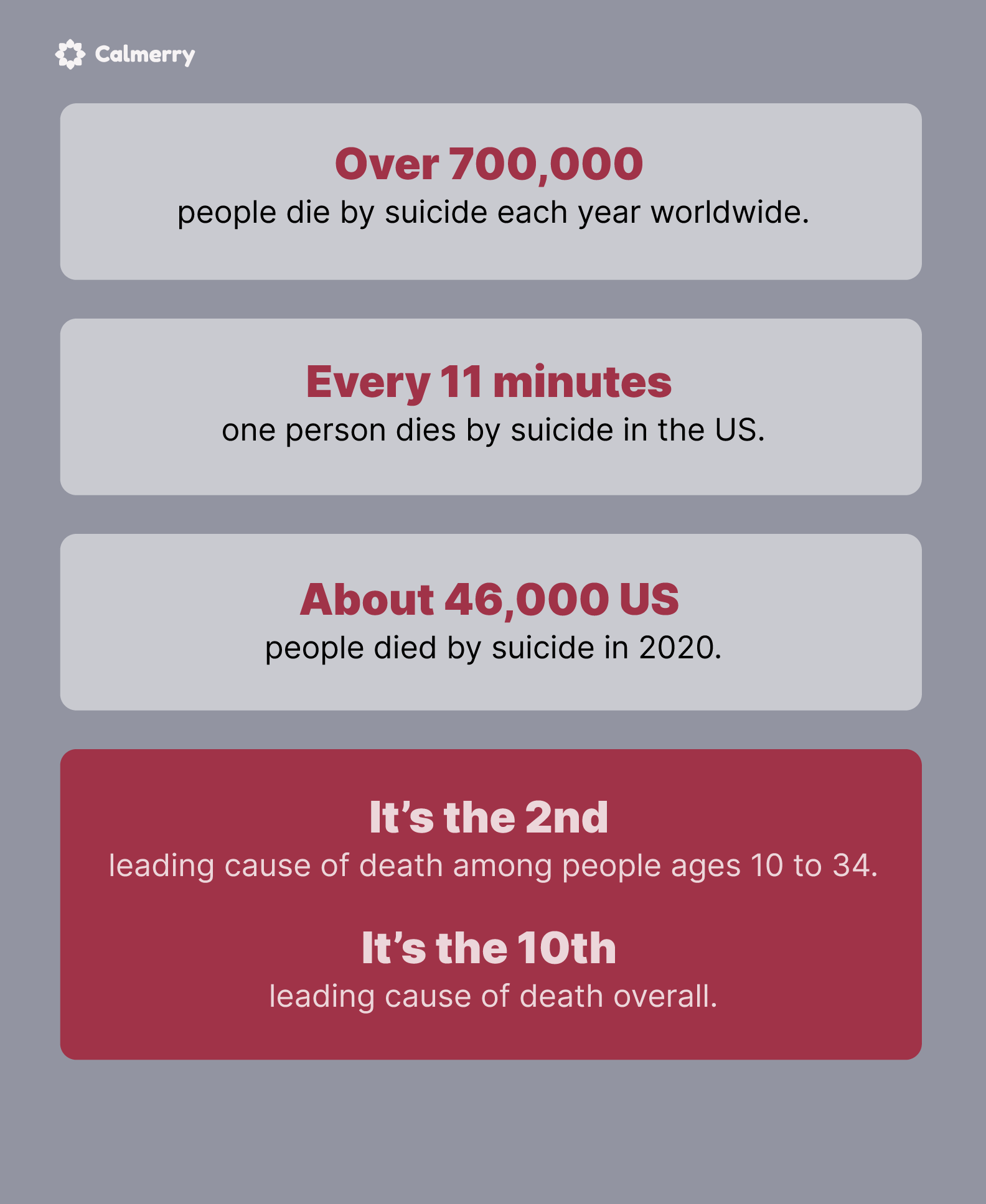How to Help Someone Who Is Suicidal

In this article
If you or someone you know is considering suicide, contact the National Suicide Prevention Lifeline 1-800-273-TALK (8255) (En Español: 1-888-628-9454; Deaf and Hard of Hearing: 1-800-799-4889) or the Crisis Text Line by texting HOME to 741741.
If you’re on social media, you can access support on different platforms. If it’s a life-threatening emergency, dial 911 or your local emergency number.
In many cases, suicide can be prevented. If you learn what the risk factors and warning signs are, you’ll be best positioned to identify when someone in your life needs help and know which steps to take to support them.
When you notice someone important to you is struggling, it can be sad, scary, and hard to figure out how to help. It’s tempting to sweep it under the rug, hope that it resolves on its own, or offer a lot of unsolicited advice in an attempt to snap them out of it. In truth, none of these tactics are very effective.
If you’re concerned that someone you care about is suicidal, take it seriously.
What is suicide?
Suicide occurs when a person self-inflicts death with the intent to die. A suicide attempt is when a person acts with the goal of ending their life but does not die.
Suicide is more common than you may think. Worldwide, more than 700,000 people die by suicide each year. [1] World Health Organization: WHO. (2023). Suicide. www.who.int. https://www.who.int/news-room/fact-sheets/detail/suicide
In the US, one person dies by suicide every 11 minutes, and it’s the second leading cause of death among people ages 10 to 34. [2] Facts About Suicide | Suicide | CDC. (n.d.). https://www.cdc.gov/suicide/facts/index.html It’s the tenth leading cause of death overall. In 2021, we lost over 48,000 people to suicide.

What are suicidal thoughts?
Suicidal ideation involves thoughts or ideas about suicide that often wax and wane over time. This means that a person can experience abstract thoughts for a few minutes one day and later experience more intense thoughts for a much longer period or not think about it again for years.
Some people think about it in concrete terms. A national survey has shown that 6% of 18 to 25-year-olds have thought seriously about trying to kill themselves throughout the year. [3] Harmer, B., Lee, S., Duong, T. V. H., & Saadabadi, A. (2023). Suicidal Ideation. In StatPearls. StatPearls Publishing. https://pubmed.ncbi.nlm.nih.gov/33351435/
It also found that most people who have suicidal thoughts do not actually attempt suicide. For every 31 Americans who have suicidal ideations, one will attempt suicide.
There’s no typical pattern, level of intensity, or set of thoughts that tend to happen. Therefore, suicidal thoughts can range in:
- How abstract or concrete they are
- How intense they are
- How the intensity shifts over time and how rapidly that shift occurs
- How long they last
Some people may also feel guilty for considering suicide when they know it will hurt people in their life who care about them. They may convince their loved ones that they are coping well, or they may not be able to find the words to speak about it. Others will talk freely about their suicidal thoughts.
Why might someone consider suicide
There are multiple reasons why a person may consider ending their life, including escaping:
- What feels like an impossible or unfixable situation
- Unbearable thoughts or feelings
- Physical pain or incapacity
They might feel that:
- They have let themselves or the people around them down
- They are a burden
- They are not needed
- There’s no point in living
- They won’t be able to solve their predicament
- They’ve lost everything worth living for
- They’re stuck
- Things will never improve
- There’s no future without pain
- They’re not worthwhile
- No one cares about them
Can suicide be prevented?
In many–but not all–cases, suicide can be prevented. The best way you can help is to learn the risk factors and warning signs, offer caring, non-judgemental support, ask directly if the person is considering harming themselves, and get them connected to trained professional help.
Risk factors
While suicidal thoughts and feelings can happen to anyone and there is typically not a single cause, there are some known risk factors which include:
- Difficult life experiences, including childhood trauma, abuse, or bullying
- Upsetting life changes such as a breakup, the death of a family member or pet, diagnosis of a major illness, or going to jail
- Anger, violent, or impulsive behavior
- Misuse of alcohol or drugs
- Isolation and lack of social support
- Feelings of hopelessness
- Mental health issues including depression, schizophrenia, substance use disorder, anxiety disorders, or a personality disorder
- Physical health conditions, including chronic pain or a terminal illness
- Financial or legal problems
- A history of self-harm (which is not the same as feeling suicidal or a suicide attempt)
- A previous suicide attempt
- Having a family member or friend who died by suicide
- Awareness of an increased number of local suicides or media coverage of deaths by suicide

That said, family and friends are often the first to recognize the warning signs and are well-positioned to intervene.
Warning signs
It’s very hard to interpret how another person is feeling, and with suicide, sometimes there are no warning signs at all. It’s important not to blame yourself if you did not pick up on another person’s suffering.
On the other hand, it’s just as important to take all signs of suicidal behavior seriously. If you have reason to believe that someone you know is considering suicide based on their words or actions, don’t ignore it or play it down with the hopes that it will resolve on its own.
Some warning signs to look out for include:
- Talking about suicide (“I wish I were dead,” “You’d all be better off without me,” “I want to kill myself,” “I want to go to sleep and never wake up,” “There’s no reason to go on.”)
- Expressing feelings of hopelessness or being trapped without viable solutions
- Expressing emptiness or loss of reason to live
- Acquiring the means to kill themself, including a firearm or stockpiling pills
- Giving away belongings or getting affairs in order, such as making a will, cleaning their room
- Saying goodbye to people as if for the last time
- Engaging in risky or self-destructive behaviors, including reckless driving
- Showing a preoccupation with death, dying, or violence
- Researching ways to kill themself
- Withdrawing from family and friends (including virtually during the pandemic)
- Losing interest or pleasure in activities they previously enjoyed
- Having mood swings
- Experiencing a sudden calmness after a period of sadness or moodiness
- Developing a change in their personality
- Changing regular routines or patterns like sleep and hygiene
- Engaging in self-harming behaviors
- Increasing their use of alcohol or drugs
- Being anxious, angry, or agitated
- Talking about being a burden to others
How to support someone who has suicidal thoughts
While you’re not responsible for preventing someone from taking their own life, it’s important to take suicidal comments or actions seriously.

A good place to start is to understand whether there is an immediate need for action, including finding out whether anything has already been done to try to kill themselves before talking with you.
You can also explore if they have a plan in place for the future and, if so, when that plan will take place. In general, the more complete the plan, the higher the immediacy and severity of the risk.
If the risk is immediate
If someone you know is at imminent risk of ending their life, dial 911 or your local emergency number right away. If you’re with them and it’s safe for you to do so, don’t leave them alone and remove anything they can use to hurt themselves. See if you can get them to agree to hold off while you get support in place.
After you’ve alerted emergency personnel, try to tell a trusted family member or friend about what’s happening so that more people can assist. You’re not left to manage the situation on your own. You can also drive them to the nearest hospital or emergency room if that can be done safely.
If the risk is not immediate
While all indications of suicidality should be taken seriously, it is not always an emergency.
If they’re not in immediate danger and you’re not sure where to start, consider:
- Letting them know you care and they’re not alone
- Recognizing the pain they’re in
- Being non-judgmental
- Actively listening to what they’re saying
- Asking about any reasons they have for living
- Asking whether they’ve felt like this before and what happened in the past when thoughts like this came up for them
- Finding out whether they have a plan for ending their life and what the plan is
- Encouraging them to seek help from a trained support person (a starting point might be the National Suicide Prevention Lifeline)
- Offering to research or make the calls to help them connect with a trained mental health provider
- Following up with them and being available
- If possible, removing dangerous items from their access, including sharp objects, weapons, ropes, excess medications, or belts
- Getting professional support for yourself
What to say to someone who is suicidal
If someone has opened up to you about their suicidal thoughts, it’s a gesture towards safety. While there’s a good chance you won’t come up with a solution right then and there, the main goal is to keep them safe, listen, support them in getting professional help, and let them know you appreciate their openness and that you care about them.
If they haven’t told you outright, but your instinct is telling you that something is up, you can start the conversation by pointing out why you’re concerned (e.g., they haven’t been showing up for plans, they’re making comments that raise your internal alarm).
Let them know that you care about them and recognize these signs as potential indications that a person is thinking about ending their life. Then ask directly if that’s the case for them. You can simply say, “Are you thinking about ending your life?” or “Are you having thoughts about suicide?”

Keep in mind that asking someone does not make suicide more likely to happen. In fact, in some cases, it may reduce suicidal ideation. [4] Dazzi, T., Gribble, R., Wessely, S., & Fear, N. T. (2014). Does asking about suicide and related behaviours induce suicidal ideation? What is the evidence? Psychological Medicine, 44(16), 3361–3363. https://doi.org/10.1017/s0033291714001299
In addition to your direct question, you can also ask questions like:
- How are you holding up with everything that’s been going on in your life?
- Have you ever thought about suicide in the past?
- Do you have thoughts about how or when you’d do it?
- Are you thinking about killing yourself in the next day or so?
- How strong are your urges?
If it turns out they are thinking about suicide, even if there’s no imminent threat, don’t promise to keep it a secret. Instead, try to remain non-judgemental. Remember that acknowledging the other person’s feelings is not the same as agreeing with them. Ask open-ended questions and explore what you can do to help.
Encourage them to get support from a trained professional or counselor, including connecting to:
- A suicide hotline like the National Suicide Prevention Lifeline at 800-273-TALK (800-273-8255) or the TrevorLifeline at 1-866-488-7386
- A therapist (for some people experiencing suicidal thoughts, dialectical behavior therapy is beneficial)
- A support group or crisis center
And offer to help take steps to make that happen.
Once you’ve acknowledged the other person’s feelings, you can also offer hope and reassurance that things can get better with treatment. Be curious about coping strategies that have helped in the past and remind them that they are not alone or a burden to you.
It’s also important to regularly follow up with the person. If you’re not able to be there consistently or you’re far away, talk with them about who else might be able to help. Connectedness is a protective factor against suicide. The Lifeline, a therapist, and other community and social supports can help a person to feel less overwhelmed and less suicidal.
What not to say
It can be just as helpful to think about what not to say as you’re considering how to support someone who has suicidal thoughts. A few things to avoid include:
- Giving advice or arguing
- Promising that you’ll keep their suicidal feelings a secret
- Telling them to “cheer up,” “get it together,” or “snap out of it”
- Explaining that there’s no good reason to feel the way they do
- Pointing out that their life isn’t that bad
- Changing the subject
- Daring them to go through with it
- Debating whether suicide is right or wrong
- Lecturing them on the value of life
- Minimizing their experience
- Telling them that everyone has problems
Trying to talk them out of feeling the way that they do will likely shut down communication. For example, responses like “things could be worse” or “there’s so much to live for” may feel true to you, but they are disregarding the other person’s experience.

The idea is to not contribute to feelings of rejection, loneliness, guilt, shame, or being misunderstood.
Help them make a safety plan
When the person you care about is not in immediate danger of attempting suicide, you can also support them by encouraging them to create a plan to stay safe when a crisis arises. If they’re already working with a counselor or mental health professional, they may already have a safety plan in place.
In general, a safety plan is an individualized plan that reviews how to cope when suicidal feelings get stronger. It can include warning signs to pay attention to, specific people or hotlines to reach out to, and actions including removing certain objects from the home, refraining from isolating yourself, and engaging in certain activities like painting, singing, spending time with a pet, or watching a movie.
It can also include things like creating a “hope box” that is filled with items or reminders of what is beautiful in your life and what there is to keep living for.
Explore suicide prevention resources
There are several organizations focused on suicide prevention where you can find more information, including:
- American Foundation for Suicide Prevention, which offers connections to local chapters, support groups, and information
- Suicide Prevention Resource Center is a federally supported resource center that offers training, consultation, logistical support, and information
- National Suicide Prevention Directory, which includes a comprehensive database of suicide prevention agencies across the country
- Suicide awareness voices of education that raise public awareness and offer training and grief support groups
- The Trevor Project offers nationwide 24/7/365 crisis intervention and suicide prevention services through the TrevorLifeline and confidential text-based counseling through TrevorText for LGBTQ+ young people under 25 years. You can also chat with a counselor through the website.
- The National Organization for People of Color Against Suicide addresses suicide prevention and intervention in communities of color
Get support for yourself

Supporting someone who is having suicidal thoughts can have a big impact on you. Your online therapist can work with you to process your feelings and help make sure that you’re taking care of yourself.
It is easy to get sucked into a caretaker role and lose track of what you’re going through. But caring for others works best when you’re caring for yourself. In therapy, you can connect back to yourself and make sure your basic needs are met while having your own personal support system to get through it with.
World Health Organization: WHO. (2023). Suicide. www.who.int. https://www.who.int/news-room/fact-sheets/detail/suicide
Facts About Suicide | Suicide | CDC. (n.d.). https://www.cdc.gov/suicide/facts/index.html
Harmer, B., Lee, S., Duong, T. V. H., & Saadabadi, A. (2023). Suicidal Ideation. In StatPearls. StatPearls Publishing. https://pubmed.ncbi.nlm.nih.gov/33351435/
Dazzi, T., Gribble, R., Wessely, S., & Fear, N. T. (2014). Does asking about suicide and related behaviours induce suicidal ideation? What is the evidence? Psychological Medicine, 44(16), 3361–3363. https://doi.org/10.1017/s0033291714001299
online therapy
live video session



